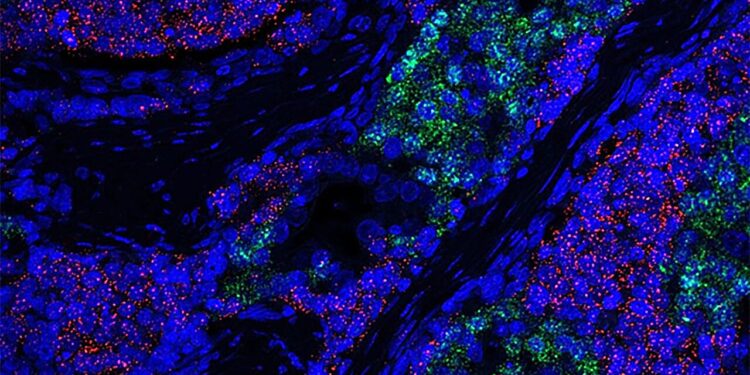In a new study, UCLA researchers have demonstrated how two subsets of small cell neuroendocrine prostate cancer tumor cells (shown in red and green) can arise from less aggressive prostate tumors. Credit: Chia-Chun (Olga) Chen and Tyler Sugimoto/UCLA
As cancers grow and spread in the human body, they tend to become more aggressive over time, which can accelerate during treatment as they develop resistance to drugs. In prostate cancers, some progress to a rare, treatment-resistant tumor known as small cell neuroendocrine cancer, or SCN.
Now, for the first time, researchers have recorded and detailed the molecular steps that transform a more common type of prostate cancer into SCN cancer. A better understanding of this tumor evolution could lead to new therapies to prevent the development of SCN prostate cancers.
“For the first time, we have a real opportunity to define the process that causes these very, very aggressive tumors,” said Dr. Owen Witte, who co-led the new research with Thomas Graeber. Both researchers are members of the Eli and Edythe UCLA Broad Center for Regenerative Medicine and Stem Cell Research and the Jonsson Comprehensive Cancer Center.
SCN cancers make up only a small percentage of all newly diagnosed prostate cancers, but they are more common among tumors that continue to grow after treatment. In both cases, SCN prostate cancers grow particularly quickly and are difficult to treat. Although researchers have already identified molecular differences between the more common prostate adenocarcinomas and SCN cancers, they have not understood how these changes occur.
“Until now, we didn’t have a concrete timeline for how these small cell neurodendocrine cancers arose, so it’s been very difficult to design approaches to treat them in the clinic,” Graeber said.
In the new study, published in Cancer cellThe researchers used a prostate cancer model in which healthy human prostate cells are implanted into a mouse and then coaxed or engineered to become adenocarcinomas and then SCN cancers.
“Starting with normal cells and following them through this progression gave us a unique ability to track exactly what was happening at each moment,” said Olga Chia-Chun Chen, a graduate student at Broad Stem Cell Research Center Training. from UCLA. Program and first author of the study.
Chen and his colleagues collected biopsies of the tumors every two weeks for at least 10 weeks and performed detailed analyzes of the genetic programs activated at each time point. Despite the dozens of differences between prostate adenocarcinomas and SCN cancers, the team found that prostate adenocarcinomas followed only two predictable pathways to progress to SCN cancers. Researchers have also shown that some lung cancers follow similar paths to progress to SCN cancers.
“It was a real surprise that there were only two main tracks,” Graeber said. “And that gives us a lot of hope for therapeutics, because it’s much easier to figure out how to block two pathways rather than hundreds.”
The researchers plan future studies to develop methods to block these newly discovered evolutionary pathways. Several of the molecular changes they identified as critical to the progression of SCN cancer can potentially be targeted by drugs. Rather than taking on the difficult challenge of developing drugs to treat full-blown SCN prostate or lung cancers, researchers hypothesize that the drugs could instead block the progression of less aggressive subtypes so that the cancers SCN cannot appear.
“The message here is that this is a repeatable process that cancers follow to become more aggressive, and if we can predict that a cancer is going down this path, we may be able to prevent it,” Witte said.
More information:
Chia-Chun Chen et al, Time course reveals bifurcated lineages in aggressive neuroendocrine small cell prostate cancer trans-differentiation, Cancer cell (2023). DOI: 10.1016/j.ccell.2023.10.009
Provided by University of California, Los Angeles
Quote: Researchers detail how prostate cancers grow more aggressively to evade treatment (November 29, 2023) retrieved November 30, 2023 from
This document is subject to copyright. Except for fair use for private study or research purposes, no part may be reproduced without written permission. The content is provided for information only.



